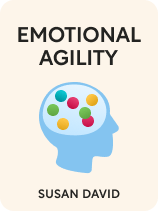

This article is an excerpt from the Shortform book guide to "Emotional Agility" by Susan David. Shortform has the world's best summaries and analyses of books you should be reading.
Like this article? Sign up for a free trial here.
What’s the best way to make lasting change? How are internal narratives created?
In Emotional Agility, Susan David explains that most people react instinctively to their perceptions of events, which are based on emotional (often untrue) narratives explaining why those events took place. David argues that you can break free of these controlling narratives by practicing emotional agility.
Keep reading for a few Emotional Agility quotes that provide insight into the book’s concepts.
Susan David’s Emotional Agility Quotes
Emotional agility is the ability to see events and your emotions objectively so you can live with purpose and clarity. We’ve collected a few Emotional Agility quotes and provided them along with some context and explanation to help you understand David’s ideas.
“When we show up fully, with awareness and acceptance, even the worst demons usually back down.”
The second step of developing emotional agility is accepting your emotions. This means compassionately giving yourself permission to feel, struggle, and fail. You’ll acknowledge that neither the act of feeling unwanted emotions—particularly guilt and shame—nor the act of believing inaccurate narratives make you less of a person.
To achieve acceptance and self-compassion, David encourages you to look at your own faults and flaws as you would those of a loved one or a young child—with forgiveness. This strips away the accusatory power that self-narratives often hold.
“In looking for the right places to make these tiny changes, there are three broad areas of opportunity. … When we learn how to make small changes in each of these areas, we set ourselves up to make profound, lasting change over the course of our lives.”
David emphasizes three avenues for successful, gradual change: your belief in your abilities, your attitude toward change, and your routines.
To escape controlling narratives of fear and helplessness, David urges you to choose to believe that you’re capable of change and growth. Studies show that you’re more likely to succeed in your goals for change when you believe that capacity is within your power.
The work of pursuing your goals—spending hours job hunting, for example—can feel like an unpleasant chore. This can make you less likely to follow through with your goals in the long term. To combat this frustration, reframe your responsibilities and tasks as things you genuinely want to do—and as stepping stones toward goals that you also want to achieve.
In addition to prompting your emotional reactions to narratives, your body and brain also drive you toward instinctive actions requiring little to no conscious thought: routines. When you repeatedly make the same desired choice—perhaps choosing fruit over candy if your value is “healthy eating”—that choice gradually becomes an instinctive routine.
“The parent who praises a child’s accomplishment by saying, ‘You studied hard!’ promotes a growth mindset. The parent who says, ‘Look at your A, son! You’re a genius!’ promotes a fixed mindset.”
Your brain often makes mistakes when interpreting meaning from sensory information—and, because it relies on these faulty interpretations to form narratives, the narratives it creates don’t always reflect objective reality. Narratives deliver information through an internal stream of consciousness that constantly fills your mind with thoughts, associated memories, and emotions. When you reflect on these thoughts, this inner voice also drives you to judge yourself through the lens of your narratives. David says these self-judgments create emotions of inadequacy and frustration.
“Who’s in charge—the thinker or the thought? Are we managing our own lives according to our own values and what is important to us, or are we simply being carried along by the tide?”
David explains that everyone has values, whether they realize it or not—though for most people, many of these values are intrinsically tied to unconscious narratives. David recommends contemplating the values others impose on you. Examine your behavior across different settings in your life. Do you act or speak differently around friends, family, and others? If so, why? Does this arise from a desire to appease or impress others who value certain behaviors more than you do?
“Determing what you truly care about is only half the process of walking your why. Once you’ve identified your values, you then have to take them out for a spin.”
David gives advice on how to determine your values: Ask yourself what life you’d pursue if you had no obstacles or stress standing in your way. When you go to bed each night, think over your day and decide what parts of it were valuable and which didn’t feel fulfilling. Imagine what your future self might think of your current values—and where those values will lead you in the future.

———End of Preview———
Like what you just read? Read the rest of the world's best book summary and analysis of Susan David's "Emotional Agility" at Shortform.
Here's what you'll find in our full Emotional Agility summary:
- Why most people react instinctively rather than objectively
- How to live according to your values to create the life you want
- How to handle your emotions better using mindfulness techniques






